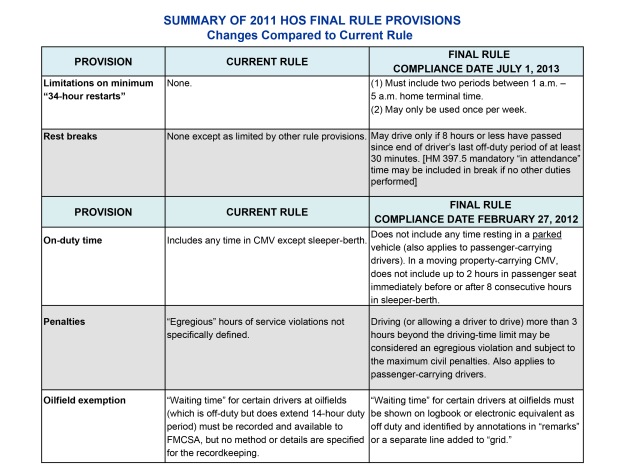There is no doubt; things are certainly beginning to get better for tractor-trailer and other heavy equipment drivers. It also means that in some areas of the country finding the right people to place behind the wheel has become more of a challenge.
 According to the most recent job figures from the U.S. Bureau of Labor Statistics, unemployment rates in the transportation industry dropped to just above 9 percent in the past 12 months. That still might be higher than the national average (around 7.8 percent), but these job numbers are showing a picture better than it was at its peak, when it hovered above 10 percent.
According to the most recent job figures from the U.S. Bureau of Labor Statistics, unemployment rates in the transportation industry dropped to just above 9 percent in the past 12 months. That still might be higher than the national average (around 7.8 percent), but these job numbers are showing a picture better than it was at its peak, when it hovered above 10 percent.
Truckers: Valuable Part of the American Economy
In 2012, more than 90,000 Americans have found jobs in the transportation industry in the past year. Add to that the fact that trucking accounts carry 80 percent of all consumer goods, and you have an extremely valuable portion of the American economy.
The area of the transportation industry that employs the most individuals is General Freight Trucking, which includes heavy and tractor-trailer drivers. Nearly 600,000 drivers represent more than 62 percent of the entire transportation industry.
In addition, tractor-trailer driver income is getting better. In 2013, they can now expect an average hourly wage of more than $20 per hour, with an annual mean wage for $41,680. In May of 2010, the median annual earnings of heavy and tractor-trailer truck drivers were only $37,770.
Higher Competition Equals Higher Driver Wages
When considering which areas of the country are the “most expensive” places for a trucking company to hire drivers, two factors happen to be the most important: industry employment rates and relative wages.
For most trucking companies, the main issue is higher pay. Companies looking to recruit in certain geographic areas will have to spend more money to attract qualified drivers. Higher wages equals greater competition for the right people to get behind the wheel of their vehicles (or to hire independent contractors).
That makes finding the right employees in any geographic area is a double-edged sword. On one hand, there are certain regions that pose a higher challenge for trucking companies. On the other, those same regions (for the most part) pay drivers the highest and have the greatest numbers of companies clamoring to find qualified truckers.
Top five most expensive places in the U.S. for a company to recruit drivers:
#5: Eastern Illinois/Chicago
To hire drivers in the Chicago metropolitan area, it’s going to cost a company more money than almost any other region in the contiguous 48 states (more about that later).
The Chicago metro area, which includes Joliet and Naperville, ranks highest on the list. The area offers drivers an hourly mean wage of $23.96, equating to an annual median salary of nearly $50,000.
#4: Texas
Everything is bigger in Texas, especially the heavy tractor-trailer industry. There are certainly more truckers in Texas than anywhere else. With the highest number of drivers per thousand jobs, the competition for qualified truckers in Texas is fierce.
On a bright note, the average driver pay in Texas is slightly below average, at just above $40,000 per year. This makes the Lone Star State a relative bargain, compared to others on this list.
#3: Southern California
Texas may be bigger than California in size, when it comes to finding highly qualified drivers; the Southern California sunshine just might beat the Texas heat. Between the Los Angeles and Riverside-San Bernardino metropolitan areas, a combination of high trucker employment and the overall number of trucker jobs is more than 30 percent below the U.S. average.
For companies in the transportation industry, this means it will take considerably more effort to find qualified truck drivers looking for work than in other parts of the country. However, trucking wages are right at the national average at $41,500 annually.
#2: Joplin, MO
Southern California transportation industry may have its challenges for business looking for qualified employees; however, Joplin, Missouri deserves specific mention. Of any single city (as opposed to a geographic region) in the United States, Joplin has (by far) the most number of employed truckers as a percentage of total jobs. Six percent of ALL JOBS in Joplin are in the heavy and tractor-trailer industry, making it a paradise for truckers, but a headache for companies looking to avoid having to outbid other businesses for the best on-the-road talent.
The bottom line is that if you are a big-rig driver in Joplin, chances are you already have a decent job, and are not looking to change. To attract drivers, a company will have to pay quite a bit more than the regional average of $46,000 a year.
#1: Alaska
Compared to anywhere in the entire U.S., drivers have it the best in the Great White North. The good life for truckers suggests trucking companies can expect to be hit the hardest (at least financially) when finding qualified employees in the area.
Alaska has relatively low trucker unemployment as well as a high “location quotient,” where the concentration of workers in that occupation is significantly higher than the national average.
What puts Alaska tops of the list is not one, but two of the highest paying cities for heavy tractor-trailer drivers in the entire U.S. Fairbanks tops the entire country in average wages for driver pay, with the highest per hour wage of $25.27, and drivers can expect an average annual salary of more than $52,500. Anchorage also makes the top five in gross wages, with average hourly earnings of $24.31.
The BEST place to find tractor-trailer drivers in the United States is…
Florida
With one of lowest average annual salaries for heavy and tractor-trailer drivers—a “bargain basement” $36,310—Florida also has one of the lowest percentages of trucking jobs in the region. Those numbers make Florida the place to beat for have best chances of hiring qualified truckers at a reasonable salary.
What’s more, the economic recovery from the 2008 downturn is beginning to gain steam in the Sunshine State. The April 2013 overall unemployment numbers came in at 7.2 percent, much lower than the national average.
For trucking companies in the need for well-qualified drivers, especially in the Southeast U.S., the numbers show that the time to hire skilled drivers in Florida is right now. Act quickly and you will see the best “bang” for your employment dollar!
27.773056
-82.640000




